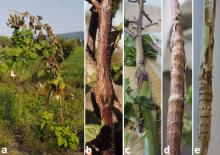Pest description and crop damage Rose stem girdler (Agrilus cuprescens) is a small copper-green-colored beetle in the family Buprestidae. It is a pest of caneberry crops and ornamental brambles (Rosa and Rubus spp.). RSG is relatively new to the PNW and damage is increasingly being reported throughout the south Puget Sound basin to the Willamette Valley region of western Oregon. It has also been confirmed in the inland PNW. Infestations can reduce berry yield or kill canes. Damage patterns in infested regions or within fields may be highly variable and confined to certain “hotspots” where infestation is particularly heavy, and damage may be severe. Economic loss is most reported in young plantings that are not yet well-established, and/or on primocane varieties grown for fall harvest. Damage to established floricane plantings can be a relatively inconspicuous yield decline, partially due to the infestation going unnoticed. If substantial girdling does not occur before harvest, RSG damage may superficially resemble typical cane senescence after harvest or wilting from Phytophthora root rot. Canes with feeding damage are also more susceptible to winter injury. RSG may commonly begin to infest an area through infested nursery stock/transplants or move incrementally through corridors where wild hosts are abundant. The abundance of wild Rosa and Rubus species in the western PNW can lead to persistent RSG corridors along roadsides, railroad tracks, fields, and waterways, making eradication impractical.
Adult beetle emergence is dependent on average humidity and temperature thresholds: 1) Pupation requires average daytime temps >50°F and >60% average daily relative humidity, and 2) development into an adult requires average daytime temps >55°F and >70% average daily relative humidity. Therefore, cool and/or dry spring conditions can delay RSG emergence. Once adults have developed, they may stay in canes for 1 to 3 weeks until average daytime temps are >65°F. After this latent period (most commonly early June in the PNW), adults will emerge from the stem, leaving behind a D-shaped emergence hole.
Peak adult emergence and activity may occur over a 2- to 3-week period, but residual activity has been observed to last for up to 8 weeks or longer in the PNW. Individual adults live for ~1 week once they emerge and have been estimated to move up to 300 ft from their emergence location within a season. Prior to egg-laying, adults feed on leaves, which can result in a tattered appearance. Once reproductively mature, females most commonly lay eggs on the basal 1/3 of primocanes or multiple points higher up on older canes. Eggs hatch within two weeks and flat-headed larvae bore directly beneath their eggshells into the canes. Larvae are cream-colored and during early summer feed within the vascular tissue resulting in a characteristic spiral and/or gall-like swelling on canes. Spiral damage patterns may be more prominent on infested second-year canes, whereas prominent galling may be particularly apparent on first-year and/or soft and tender canes. Damage from larvae can eventually have a girdling effect on the cane leading to wilted top-growth beginning in mid-summer through fall. Weakened canes may easily snap, particularly if weighted by ripening berries or during cane-tying/trellising operations. By early fall, most larvae will have moved into the cane pith where they remain until the following year. Larvae do not always remain viable in the cane, which may be partially due to buildups of naturally occurring parasitoid wasps that follow an infestation and reduce RSG activity in the following year. When this happens, infestation symptoms may be apparent, but damage to cane vitality may appear negligible.
Management-chemical control—HOME and COMMERCIAL USE
Diligent, thorough pruning and destroying of RSG-damaged canes can help reduce field populations considerably (up to 80%). Insufficient field cleanup has been observed to lead to buildups of pest populations even when insecticides are used. Larvae are unlikely to survive in canes if pruned out before late summer but can remain viable in canes pruned after they reach their overwintering stage inside the cane pith. If these later-pruned canes are left in the field, they should be thoroughly destroyed and/or tilled below 2 inches to prevent emergence the following year. Generally, any production system where canes are absent when adults are active and/or where canes are mowed after infestation may lessen the risk of in-field RSG issues in a given year. Integrating effective insecticides with pruning practices may provide near-full control of in-field populations, though RSG may still enter fields annually from infested wild hosts on the edges. There are no insecticides specifically labeled for RSG control but a list of caneberry insecticides that are effective on RSG has been published in the Utah State University Extension guide, ENT-178-15. Sprays need to be targeted at the adult beetles to prevent egg-laying. Insecticide applications made before adults emerge are ineffective. Growers may choose to prioritize new/young caneberry plantings and/or fall-harvest primocane varieties for chemical management if necessary. Scouting for RSG can be difficult because beetles are often not abundant enough to be easily spotted but are most likely to be seen on caneberry leaves between late May and mid-June in the western PNW. Once adults have emerged, weekly applications should be applied as full cover sprays, including the basal area of the canes, beginning immediately at adult emergence, and continued while adults are present. Because adults can emerge around bloom, follow all pollinator guidelines that may appear on the pesticide labels.



